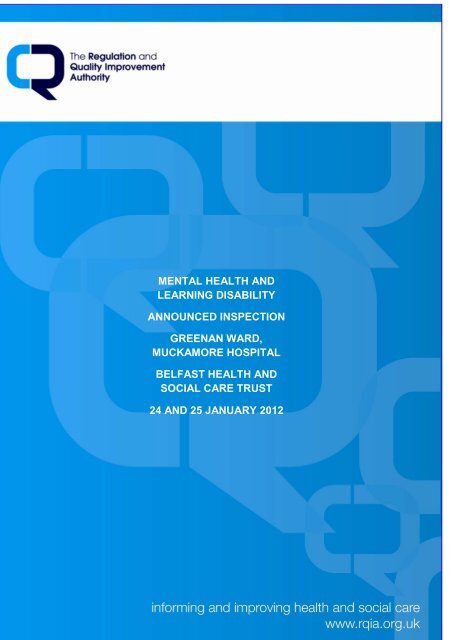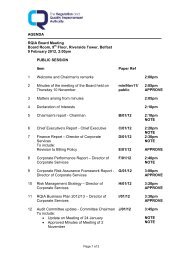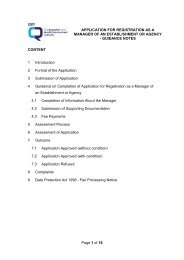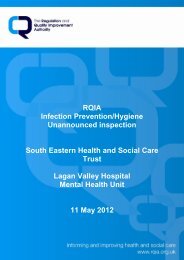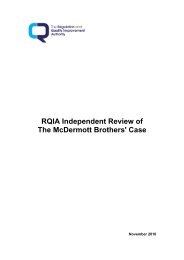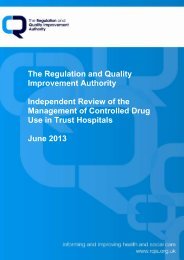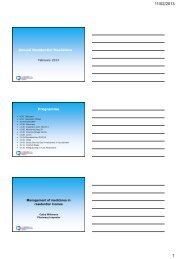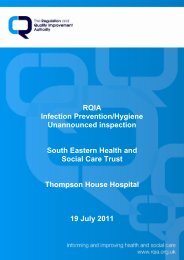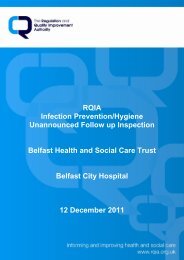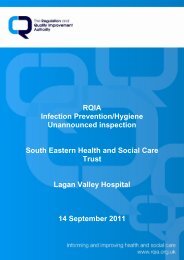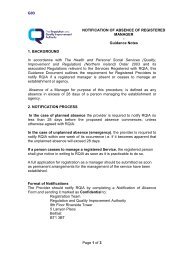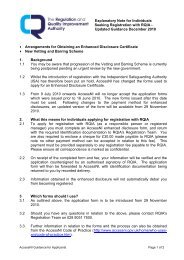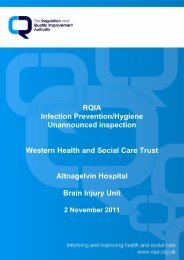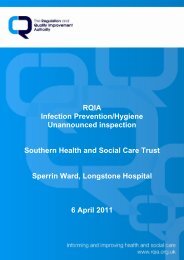Greenan Ward, Muckamore Hospital - 24 and 25 January 2012
Greenan Ward, Muckamore Hospital - 24 and 25 January 2012
Greenan Ward, Muckamore Hospital - 24 and 25 January 2012
Create successful ePaper yourself
Turn your PDF publications into a flip-book with our unique Google optimized e-Paper software.
MENTAL HEALTH AND<br />
LEARNING DISABILITY<br />
ANNOUNCED INSPECTION<br />
GREENAN WARD,<br />
MUCKAMORE HOSPITAL<br />
BELFAST HEALTH AND<br />
SOCIAL CARE TRUST<br />
<strong>24</strong> AND <strong>25</strong> JANUARY <strong>2012</strong><br />
1
Table of Contents<br />
1.0 Introduction ............................................................................................ 3<br />
2.0 <strong>Ward</strong> Profile ........................................................................................... 5<br />
3.0 Inspection Summary .............................................................................. 6<br />
4.0 Stakeholder Engagement ...................................................................... 8<br />
5.0 Additional Concerns Noted by Inspectors .............................................10<br />
6.0 RQIA Compliance Scale Guidance ......................................................11<br />
Appendix 2 – Unannounced Visit ...................................................................15<br />
Appendix 1 – Quality Improvement Plan ...........................................................<br />
2
1.0 Introduction<br />
The Regulation <strong>and</strong> Quality Improvement Authority (RQIA) is the independent body<br />
responsible for regulating <strong>and</strong> inspecting the quality <strong>and</strong> availability of Northern<br />
Irel<strong>and</strong>’s health <strong>and</strong> social care services. RQIA was established under the Health<br />
<strong>and</strong> Personal Social Services (Quality, Improvement <strong>and</strong> Regulation) (Northern<br />
Irel<strong>and</strong>) Order 2003, to drive improvements for everyone using health <strong>and</strong> social<br />
care services.<br />
On <strong>24</strong> October 2011 RQIA informed the Belfast Health <strong>and</strong> Social Care Trust of the<br />
proposed inspection <strong>and</strong> forwarded the associated inspection documentation. RQIA<br />
adopted the approach of self-assessment, which allowed the ward the opportunity to<br />
demonstrate its ability to deliver a service against best practice indicators. This<br />
included the assessment of the trust’s performance against an RQIA compliance<br />
scale, as outlined in section 6.<br />
The inspection process included an analysis of the ward’s self-assessment, other<br />
associated information, <strong>and</strong> discussions with ward staff, patients <strong>and</strong> relatives. A<br />
range of multidisciplinary records, policies <strong>and</strong> procedures were also examined as<br />
part of the inspection.<br />
The recommendations made during the previous inspection on 18 <strong>and</strong> 19 November<br />
2010 were also assessed during this inspection to determine the trust’s progress<br />
towards compliance. The inspector found compliance in the following areas. It was<br />
noted that good progress was made in relation to: bed areas being personalised,<br />
meal times more enjoyable; enhanced information for patients <strong>and</strong> relatives; <strong>and</strong><br />
improved multidisciplinary team review performance. While some progress has<br />
been made in relation to advocacy involvement on the ward, inspectors concluded<br />
that this remains in the early stages <strong>and</strong> recommended that the roles <strong>and</strong><br />
responsibilities of advocacy services are defined <strong>and</strong> implemented.<br />
Recommendations were also restated regarding: improving ward-based activities for<br />
patients; implementation of communication care plans; <strong>and</strong> enhanced patients<br />
appropriate information material.<br />
In spite of assurances from the trust, several recommendations remained<br />
outst<strong>and</strong>ing from the previous inspection. Recommendations that were outst<strong>and</strong>ing<br />
were added to the quality improvement plan for action (reference Appendix 1).<br />
An overall summary of the ward’s performance against the human rights theme of<br />
protection is in section 3 <strong>and</strong> full details of the inspection findings are outlined in<br />
Appendix 2.<br />
3
Trust<br />
Name of hospital/facility<br />
Address<br />
Belfast Trust<br />
<strong>Greenan</strong> <strong>Ward</strong>,<strong>Muckamore</strong> Abbey<br />
<strong>Hospital</strong><br />
1 Abbey Road<br />
Antrim<br />
BT41 3SH<br />
Telephone number 02894 463333<br />
Person in charge on day of<br />
inspection<br />
Nature of service - MH/LD<br />
Name of ward/s <strong>and</strong> category of<br />
care<br />
Mary Bogue<br />
Learning Disability<br />
<strong>Greenan</strong> <strong>Ward</strong>, adult continuing care.<br />
Number of patients <strong>and</strong> occupancy<br />
level on days of inspection<br />
<strong>24</strong> beds, 20 patients during inspection<br />
Number of detained patients on<br />
days of inspection<br />
None<br />
Date of last inspection 18 <strong>and</strong> 19 November 2010<br />
Date of Inspection <strong>24</strong> <strong>and</strong> <strong>25</strong> <strong>January</strong> <strong>2012</strong><br />
Name of Inspector<br />
Margaret Cullen<br />
4
2.0 <strong>Ward</strong> Profile<br />
<strong>Greenan</strong> <strong>Ward</strong> is situated on the <strong>Muckamore</strong> Abbey <strong>Hospital</strong> site <strong>and</strong> provides<br />
continuing care to adults with learning disability <strong>and</strong> complex health care needs. The<br />
ward has <strong>24</strong> beds, four of which are in single rooms <strong>and</strong> the remainder in dormitory<br />
areas.<br />
The ward has been open since 1981 <strong>and</strong> currently accommodates female patients,<br />
some of whom have been receiving care on the hospital site for over 50 years. The<br />
ward does not take direct admissions. Patients who come to the ward are most<br />
likely to have been transferred from other wards within the hospital site.<br />
There are a number of bathroom <strong>and</strong> toilet areas on the ward; office<br />
accommodation; a dining room; <strong>and</strong> ver<strong>and</strong>a area, two large sitting rooms; a visitor's<br />
area; interview room; clinical room <strong>and</strong> a number of areas for storage of equipment<br />
<strong>and</strong> consumables. The ward has tracking for overhead hoists in the dormitory <strong>and</strong><br />
bathroom areas, <strong>and</strong> a number of portable hoists.<br />
Patients have input from a variety of multidisciplinary professionals including<br />
medical, nursing, social work, podiatry, physiotherapy, speech <strong>and</strong> language<br />
therapy, dentistry <strong>and</strong> dietetics.<br />
Approximately two thirds of the patients have ongoing family contact, <strong>and</strong> most<br />
patients have access to day care services on site. A minister of religion visits the<br />
ward regularly.<br />
The patients range in age from mid 40s to late 70s <strong>and</strong> many of patients who have<br />
complex healthcare needs, most of them requiring assistance to mobilise. Two<br />
patients require supervision at meal times, one patient requires enteral feeding <strong>and</strong><br />
the rest require feeding by a member of staff. The dependency levels of the patients<br />
on this ward are high.<br />
5
3.0 Inspection Summary<br />
An announced inspection to <strong>Greenan</strong> <strong>Ward</strong> was undertaken on the <strong>24</strong> <strong>and</strong> <strong>25</strong><br />
<strong>January</strong> <strong>2012</strong>. The purpose of this inspection was to assess the ward’s procedures<br />
<strong>and</strong> arrangements for safeguarding vulnerable adults. Inspectors did this by<br />
speaking with patients, staff, an advocate <strong>and</strong> visiting professionals. A range of<br />
multidisciplinary records, policies <strong>and</strong> procedures were also examined.<br />
The inspection was announced <strong>and</strong> took place on 23 <strong>and</strong> <strong>24</strong> <strong>January</strong> <strong>2012</strong>. The<br />
ward manager had prepared some self-assessment information prior to the<br />
inspection, <strong>and</strong> distributed a number of questionnaires to patients, their relatives,<br />
staff <strong>and</strong> visiting professionals.<br />
This inspection focused on the human rights theme of protection which included a<br />
focus on the safeguarding of vulnerable adults in <strong>Greenan</strong> <strong>Ward</strong>, <strong>Muckamore</strong> Abbey<br />
<strong>Hospital</strong>.<br />
In relation to the ward’s assessment on safeguarding vulnerable adults, inspectors<br />
concluded that while this process is evolving there was evidence to confirm that most<br />
staff are trained in this process. All staff participating in the inspection understood<br />
the criteria of abuse <strong>and</strong> the responsibility to protect the patient population. The<br />
safeguarding policy document was accessible along with an easy reference as well<br />
as other related <strong>and</strong> supporting policies <strong>and</strong> procedures. The responsibilities<br />
inherent in safeguarding are included in the trusts induction programme for new staff.<br />
A recommendation was made to incorporate this more fully into the ward induction<br />
programme.<br />
Inspectors noted good practice in relation to the knowledge of the nursing staff<br />
regarding patient’s choices <strong>and</strong> preferences. A number of templates were used<br />
which indicated good practice in relation to restrictive practices: Best interest<br />
document, protocol for unexplained scratches <strong>and</strong> bruising.<br />
The procedure for vulnerable adults documentation examined was appropriate. The<br />
ward manager indicated the need for clarification on the threshold for referral <strong>and</strong><br />
recommendations were made in relation to this.<br />
Nursing staff had recrded the risk assessment for all patients <strong>and</strong> inspectors<br />
concluded that the document was useful in summarising identified risks. There was<br />
disagreement over the usefulness of the documentation for the patient profile on this<br />
ward from another professional <strong>and</strong> therefore the assessments were not signed off<br />
as required. A recommendation was made in relation to this.<br />
There were significant measures to safeguard patients’ monies <strong>and</strong> property but<br />
recommendations were made to improve the record of items purchased. Patients<br />
<strong>and</strong> relatives indicated no concerns regarding patients’ possessions.<br />
6
Appraisal were provided for all staff <strong>and</strong> training needs are identified <strong>and</strong> monitored.<br />
Supervision was provided for trained staff <strong>and</strong> a recommendation was made that<br />
formal supervision should be provided to all staff.<br />
Overall, stakeholders were positive about the care, support <strong>and</strong> protection provided<br />
on the ward. Some patients indicated they would like more access/outings off the<br />
ward. Inspectors noted that staffing is stretched on a ward where dependency levels<br />
are high. Inspectors were advised that this impacts on activity provision for patients.<br />
Recommendations were made regarding these issues.<br />
There was no evidence indicating that patients <strong>and</strong> relatives are informed of their<br />
rights to access information or about the children’s visiting arrangements. There is<br />
no private area on the ward for visiting <strong>and</strong> recommendations have been made to<br />
address these areas.<br />
This ward does not admit under 18 year olds.<br />
Inspectors would like to thank the patients, staff, relatives <strong>and</strong> visiting professionals<br />
for their cooperation throughout the inspection process.<br />
7
4.0 Stakeholder Engagement<br />
Questionnaires were issued to staff, patients, relatives/ carers <strong>and</strong> visiting<br />
professionals in advance of the inspection. The responses from the questionnaires<br />
were used to inform the inspection process.<br />
Questionnaires issued to<br />
Number issued Number returned<br />
Patients 4 2<br />
Carers/Relatives 20 0<br />
Visiting Professional 0 5<br />
Staff 8 0<br />
During the inspection the inspector has the opportunity to meet with staff, patients,<br />
relatives/ carers, visiting professionals or advocates. Below are the details of the<br />
number of discussions held during the inspection.<br />
Additional discussions during inspection<br />
Number<br />
Patients 3<br />
Carers/Relatives 0<br />
Visiting Professionals 1<br />
Staff 4<br />
Advocates 1<br />
The following information is a summary of feedback received from those who<br />
returned a questionnaire or met with an inspector during the inspection.<br />
Staff<br />
Staff interviewed indicated satisfaction with the care provided. They indicated<br />
knowledge of the vulnerable adult’s process but confidence reported in the use of the<br />
protocol varied. However, staff did confirm that patients on the ward were vulnerable<br />
<strong>and</strong> that they were committed to their protection <strong>and</strong> would raise any issues of poor<br />
practice immediately with the ward manager.<br />
Relatives<br />
The five relative questionnaires indicated satisfaction with the care provided. Not all<br />
relatives were aware of risk assessments or the vulnerable adult’s policy but most<br />
indicated that they are kept informed of restrictive practices, incidents, progress <strong>and</strong><br />
were aware of the complaints policy. While they were not all aware of their relative’s<br />
financial situation none indicated concerns in relation to patients’ money or property.<br />
Comments made included:<br />
• “With the staffing levels provided the care is of good quality”<br />
8
• “Staff in <strong>Greenan</strong> are excellent <strong>and</strong> are always available to listen to relatives if<br />
they have any concerns, like any place of work accidents do happen but they<br />
never happen twice.”<br />
• “The nursing staff deliver a great service …..it is a vocation. I have nothing<br />
but admiration for the care workers”<br />
One improvement suggested:<br />
• “More staff, improved décor”<br />
Some of the relatives indicated their concerns regarding the future care of their loved<br />
ones stating clearly that as they had spent most of their lives in <strong>Muckamore</strong> it was<br />
their home <strong>and</strong> they did not feel they would get equal care in another environment.<br />
Visiting professionals<br />
Inspectors spoke with one visiting professional <strong>and</strong> it was apparent that there was a<br />
difference of opinion over the usefulness of the risk assessments for this patient<br />
population. This issue is discussed further in the report. This professional indicated<br />
that care on the ward was satisfactory, <strong>and</strong> no issues were raised.<br />
Patients<br />
The returned questionnaires <strong>and</strong> patient interviews indicated a good level of<br />
satisfaction with the care provided. Not all patients were aware of the vulnerable<br />
adult’s policy, but they confirmed that they are treated well <strong>and</strong> that restrictions are<br />
explained to them. They also indicated that they knew they have a right to complain<br />
<strong>and</strong> would raise issues with the ward manager. One patient interviewed alleged they<br />
were not treated respectfully on one occasion <strong>and</strong> inspectors requested that this was<br />
processed as a vulnerable adult enquiry to ensure the safeguards were invoked.<br />
Most patients indicated that they do not have concerns about their money or<br />
possessions. However one patient stated in their questionnaire that they were<br />
concerned about their property in case someone breaks it. Positive comments<br />
included:<br />
• “It’s a nice ward, I have good friends. All staff are very good to me, they treat<br />
me nice. I like ____(named nurse) to buy me things”.<br />
• “I like the other girls on the ward”.<br />
All issues <strong>and</strong> comments were discussed with the ward manager during the<br />
inspection.<br />
9
.<br />
5.0 Additional Concerns Noted by Inspectors<br />
5.1 Staffing<br />
Inspectors noted the high dependency levels of patients on the ward<br />
<strong>and</strong> were informed by the ward manager that the ward has been<br />
working with one staff member down on a regular basis. It was noted<br />
that some patients were only getting up at 11.30 am <strong>and</strong> that activities<br />
on the ward were impacted as a result of staffing. It was clear during<br />
the inspection that staff on the ward are stretched. Inspectors<br />
recommended that an audit is undertaken of the work load on the ward,<br />
inclusive of patient therapeutic time, <strong>and</strong> a Telford assessment of need<br />
should be completed.<br />
5.2 Access Off the <strong>Ward</strong>.<br />
Inspectors were informed that patient’s outings off the ward are limited.<br />
Patients interviewed raised this as an issue. Inspectors requested that<br />
this is reviewed.<br />
5.3 Staff Support.<br />
With the heavy dem<strong>and</strong> on nursing staff for patient care it was<br />
recommended that the provision of laundry <strong>and</strong> clerical support is<br />
reviewed.<br />
5.4 Environment.<br />
One toilet area on the ward is in need of refurbishment <strong>and</strong> this matter<br />
has been raised for some time. It was recommended that the needs of<br />
the patient population are assessed <strong>and</strong> the use of this space is<br />
prioritised to enhance privacy for patients. Inspectors noted the lack of<br />
a private visiting area on the ward.<br />
5.5 MDT reviews.<br />
Inspectors referred to duplications <strong>and</strong> omissions on the templates of<br />
the MDT reviews in the notes examined. They were informed that a<br />
new template has been agreed by the MDT which is in use from<br />
<strong>January</strong> <strong>2012</strong> but was not in the notes examined. It was explained that<br />
the revised processes will include restrictive practices <strong>and</strong> evidence<br />
inclusivity more fully.<br />
10
6.0 Compliance Scale<br />
Guidance - Compliance statements<br />
Compliance statement<br />
0 - Not applicable<br />
1 - Unlikely to become<br />
compliant<br />
2 - Not compliant<br />
3 - Moving towards<br />
compliance<br />
4 - Substantially<br />
Compliant<br />
5 - Compliant<br />
Definition<br />
Compliance with this criterion<br />
does not apply to this ward.<br />
Compliance will not be<br />
demonstrated by the date of the<br />
inspection.<br />
Compliance could not be<br />
demonstrated by the date of the<br />
inspection.<br />
Compliance could not be<br />
demonstrated by the date of the<br />
inspection. However, the service<br />
could demonstrate a convincing<br />
plan for full compliance by the<br />
end of the inspection year.<br />
Arrangements for compliance<br />
were demonstrated during the<br />
inspection. However, appropriate<br />
systems for regular monitoring,<br />
review <strong>and</strong> revision are not yet in<br />
place.<br />
Arrangements for compliance<br />
were demonstrated during the<br />
inspection. There are appropriate<br />
systems in place for regular<br />
monitoring, review <strong>and</strong> any<br />
necessary revisions to be<br />
undertaken.<br />
Resulting Action in<br />
Inspection Report<br />
A reason must be clearly stated<br />
in the assessment contained<br />
within the inspection report<br />
A reason must be clearly stated<br />
in the assessment contained<br />
within the inspection report<br />
In most situations this will result<br />
in a requirement or<br />
recommendation being made<br />
within the inspection report<br />
In most situations this will result<br />
in a recommendation being made<br />
within the inspection report<br />
In most situations this will result<br />
in a recommendation, or in some<br />
circumstances a<br />
recommendation, being made<br />
within the Inspection Report<br />
In most situations this will result<br />
in an area of good practice being<br />
identified <strong>and</strong> being made within<br />
the inspection report.<br />
11
NO Question Compliant Substantially<br />
Compliant<br />
1 How do you ensure that<br />
everyone involved with the<br />
ward is aware of <strong>and</strong><br />
underst<strong>and</strong>s the<br />
safeguarding vulnerable<br />
adult policy?<br />
2 List the additional<br />
procedures <strong>and</strong> guidelines<br />
that you use to support the<br />
safeguarding vulnerable<br />
adult policy.<br />
3 List the additional<br />
procedures <strong>and</strong> guidelines,<br />
aimed at promoting safe <strong>and</strong><br />
healthy working practices,<br />
which you use to support the<br />
safeguarding vulnerable<br />
adult policy.<br />
4 Outline how the ward is<br />
involved in the review of the<br />
Trust’s safeguarding<br />
vulnerable adult policy, the<br />
code of behaviour <strong>and</strong> the<br />
other associated procedures<br />
<strong>and</strong> guidelines.<br />
5 Outline how new staff are<br />
appropriately inducted into<br />
the ward.<br />
6 Describe how staff training<br />
needs, appropriate to the<br />
post/ role, are identified.<br />
7 Outline the arrangements in<br />
place for:<br />
(i) the support <strong>and</strong><br />
supervision of all staff<br />
(ii) the annual appraisal of<br />
staff <strong>and</strong> the review of<br />
volunteers.<br />
8 Describe the arrangements<br />
in place for maintaining<br />
written records of: training<br />
completed; support <strong>and</strong><br />
supervision; <strong>and</strong> annual<br />
appraisals <strong>and</strong> reviews.<br />
<br />
<br />
<br />
<br />
<br />
<br />
Moving<br />
Towards<br />
Compliance<br />
<br />
<br />
Not<br />
compliant<br />
Not<br />
Applicable<br />
12
9 Describe how the ward<br />
ensures staff <strong>and</strong> volunteers<br />
comply with the<br />
Safeguarding Vulnerable<br />
ults St<strong>and</strong>ard 4.<br />
10 Outline the steps the ward<br />
has taken to ensure that<br />
staff <strong>and</strong> volunteers are<br />
competent to recognise<br />
signs of abuse.<br />
11 Describe how the ward<br />
identifies <strong>and</strong> manages risks<br />
for individual patients.<br />
12 Outline the mechanisms<br />
used by the ward to ensure<br />
that vulnerable adults have<br />
the right to take risks in<br />
relation<br />
to their care.<br />
13 Describe how the reporting,<br />
recording <strong>and</strong> reviewing<br />
accidents, incidents <strong>and</strong><br />
near misses informs <strong>and</strong><br />
influences ward practice <strong>and</strong><br />
the risk assessment <strong>and</strong><br />
management procedures.<br />
14 Describe how the ward<br />
promotes <strong>and</strong><br />
communicates the Trust’s<br />
‘ethos of inclusion,<br />
transparency <strong>and</strong> openness’<br />
to vulnerable adults, carers,<br />
advocates, family members,<br />
staff <strong>and</strong> volunteers.<br />
15 Describe the procedures in<br />
place for carers, advocates<br />
<strong>and</strong> vulnerable adults to<br />
share concerns they may<br />
have or to make complaints<br />
about the organisation.<br />
16 Outline the steps the ward<br />
has taken to encourage<br />
carers, advocates <strong>and</strong><br />
vulnerable adults to raise<br />
concerns or make a<br />
complaint following an<br />
incident.<br />
<br />
<br />
<br />
<br />
<br />
<br />
<br />
<br />
13
17 Outline how the ward<br />
ensures that staff know <strong>and</strong><br />
comply with the records<br />
management policy.<br />
18 Outline the mechanisms the<br />
trust has in place to inform<br />
vulnerable adults about their<br />
right to access to information<br />
held about them.<br />
19 Describe how the ward<br />
ensures that staff,<br />
volunteers <strong>and</strong> visitors know<br />
about <strong>and</strong> adhere to the<br />
Code of Behaviour.<br />
20 outline how the ward<br />
safeguards patients’ rights in<br />
relation to the use of:<br />
(i) restrictions on the ward<br />
(ii) isolation/ seclusion<br />
(iii) close observation<br />
(iv) restraint<br />
21 Outline the mechanisms for<br />
the h<strong>and</strong>ling of vulnerable<br />
adults’ money.<br />
22 Outline how the ward<br />
ensures the safety of<br />
patients’ property while on<br />
the ward.<br />
23 Describe what arrangements<br />
the ward has in place for<br />
children visiting the ward.<br />
<strong>24</strong> Outline the safeguarding<br />
arrangements the ward has<br />
in place for the admission of<br />
an under 18 year old.<br />
<br />
<br />
<br />
<br />
<br />
<br />
<br />
<br />
14
APPENDIX 2 Unannounced visit to <strong>Greenan</strong> <strong>Ward</strong> <strong>Muckamore</strong><br />
Abbey 9 March <strong>2012</strong><br />
An unannounced visit was carried out to <strong>Greenan</strong> <strong>Ward</strong> <strong>Muckamore</strong> on 9<br />
March <strong>2012</strong> in response to concerns raised by a whistle-blower.<br />
RQIA’s MHLD team received an anonymous telephone call from a bank<br />
member of staff from <strong>Greenan</strong> ward MAH who raised a concern about<br />
patients being woken out of their sleep to get dressed at 6am to “assist the<br />
day staff”. She identified that it is a particular member of staff who has<br />
recently come to night duty from day duty who instigated this practice. She<br />
also indicated that this concern has been raised by other members of staff to<br />
the ward manager <strong>and</strong> nothing has been done. She prefers not to use the<br />
whistleblowing policy given that it has already been raised within the hospital.<br />
<strong>Greenan</strong> was last inspected by MHLD inspectors on the <strong>25</strong> <strong>and</strong> 26 <strong>January</strong><br />
<strong>and</strong> concerns were expressed about the lack of staff on the ward <strong>and</strong> the<br />
impact this had on patient care e.g. patients not getting up until 11.30am.<br />
Inspectors were told during Inspection that getting up at this time was the<br />
patient’s choice <strong>and</strong> inspectors recommended the review of staffing levels<br />
regarding this.<br />
An unannounced inspection took place to <strong>Greenan</strong> ward at 6.30am on Friday<br />
9 March by Patrick Convery <strong>and</strong> Janet McCusker. Inspectors met with night<br />
staff <strong>and</strong> explained the reasons for their visit.<br />
Following a tour of the ward it was observed that no patients were out of bed<br />
<strong>and</strong> staff nurse indicated that the practice did not happen while she was on<br />
duty.<br />
Care plans were examined <strong>and</strong> there was no indication that patients were to<br />
be wakened out of their sleep nor was there any indication in care plans that<br />
patients should be taken out of bed as soon as they were awake.<br />
MHLD staff met with ward manager when she commenced work who<br />
suggested that it may happen on occasions but only if patients were already<br />
awake. MHLD inspectors then met with the facility manager during the visit<br />
<strong>and</strong> sought assurances that the practice of wakening patients at 6am should<br />
not occur, <strong>and</strong> a reminder should be sent to night staff following our visit. The<br />
facility manager advised that the senior nurse on call for the hospital at night<br />
would provide an additional safeguard to ensuring that patients were not<br />
wakened from their sleep to get washed, <strong>and</strong> dressed <strong>and</strong> all those who are<br />
awake early were reported to them.<br />
15
Staffing levels were then reviewed <strong>and</strong> while there has been concerns<br />
expressed around staffing levels during the announced inspection on the <strong>25</strong><br />
<strong>and</strong> 26 <strong>January</strong>, there has been a recruitment drive since the last inspection.<br />
Assurances were given by facility manager that additional staff were being<br />
recruited <strong>and</strong> these would be allocated to <strong>Greenan</strong> <strong>Ward</strong>.<br />
The issue of sick leave was discussed <strong>and</strong> while this is currently 5 - 5.5%<br />
inspectors were informed that this was average for the <strong>Muckamore</strong> site.<br />
RQIA inspection staff were given assurances that an internal memor<strong>and</strong>um<br />
would be issued to all staff to remind them not to wake patients out of their<br />
sleep, <strong>and</strong> that any individual arrangements should be documented in care<br />
plans.<br />
The visit concluded at 8.30am <strong>and</strong> managers were informed that this would be<br />
discussed further with senior management that day. RQIA MHLD staff would<br />
continue to monitor the situation.<br />
Recommendations<br />
It is recommended that the trust reissue to staff guidance in respect of<br />
patients awake before 7am.<br />
It is recommended that the senior nurse on call for the site is informed of any<br />
patients awake <strong>and</strong> dressed prior to 7am.<br />
It is recommended that the staffing levels for <strong>Greenan</strong> <strong>Ward</strong> are continually<br />
reviewed to ensure that they receive an appropriate number of staff from the<br />
recruitment trawl.<br />
It is recommended that if a patient has a normal routine of waking early in the<br />
morning that this is clearly documented in the patients care plans.<br />
Follow up<br />
RQIA’s Head of Programme for MHLD followed up with telephone call to the<br />
hospital services/resettlement manager on afternoon following visit.<br />
The Director of MHLD also contacted the trust’s Assistant Director for<br />
Learning Disability to apprise him of the visit <strong>and</strong> to explain the reasons for the<br />
unannounced inspection.<br />
Following this report the MHLD team will continue to monitor staffing levels<br />
following this visit.<br />
16


